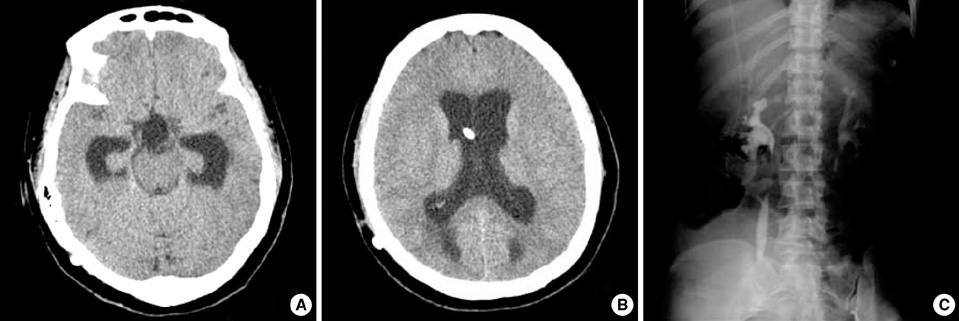J Korean Med Sci.
2010 Apr;25(4):647-650. 10.3346/jkms.2010.25.4.647.
Acute Shunt Malfunction after Cesarean Section Delivery: A Case Report
- Affiliations
-
- 1Department of Neurosurgery, Soonchunhyang University Bucheon Hospital, Bucheon, Korea. sunchulh@sch.ac.kr
- 2Department of Obstetrics and Gynecology, Soonchunhyang University Bucheon Hospital, Bucheon, Korea.
- KMID: 1792942
- DOI: http://doi.org/10.3346/jkms.2010.25.4.647
Abstract
- Shunt malfunctions that require surgical intervention during pregnancy and the postpartum period are rare. Furthermore, no study has reported on an acute shunt malfunction immediately after cesarean section. Here, we describe the case of a 32-yr-old woman who became drowsy 12 hr after cesarean section delivery of her second child. She had a ventriculoperitoneal shunt placed to treat hydrocephalus associated with meningitis at 26 yr of age. Marked ventriculomegaly was seen on brain computed tomography and her consciousness recovered temporarily after aspirating cerebrospinal fluid from the flushing device. At surgery, the distal catheter tip was plugged by a blood clot. We believe that the blood spilled over during the cesarean section. The clogged catheter end was simply cut off and the remaining catheter was repositioned in the peritoneal cavity. Her consciousness recovered fully.
MeSH Terms
Figure
Reference
-
1. Liakos AM, Bradley NK, Magram G, Muszynski C. Hydrocephalus and the reproductive health of women: the medical implications of maternal shunt dependency in 70 women and 138 pregnancies. Neurol Res. 2000. 22:69–88.
Article2. Yu JN. Pregnancy and extracranial shunts: case report and review of the literature. J Fam Pract. 1994. 38:622–626.3. Cusimano MD, Meffe FM, Gentili F, Sermer M. Management of pregnant women with cerebrospinal fluid shunts. Pediatr Neurosurg. 1991-1992. 17:10–13.
Article4. Liakos AM, Bradley NK, McAllister JP, Magram G, Kinsman SL. Hydrocephalus and pregnancy: the medical implications of maternal shunt dependency. Eur J Pediatr Surg. 1997. 7:Suppl 1. 51–52.5. Wisoff JH, Kratzert KJ, Handwerker SM, Young BK, Epstein F. Pregnancy in patients with cerebrospinal fluid shunts: report of a series and review of the literature. Neurosurgery. 1991. 29:827–831.
Article6. Nugent P, Hoshek S. Large extra-abdominal cyst as a postpartum complication of peritoneal shunt. Case report. J Neurosurg. 1986. 64:151–152.
Article7. Bradley NK, Liakos AM, McAllister JP 2nd, Magram G, Kinsman S, Bradley MK. Maternal shunt dependency: implications for obstetric care, neurosurgical management, and pregnancy outcomes and a review of selected literature. Neurosurgery. 1998. 43:448–460.
Article8. Nfonsam V, Chand B, Rosenblatt S, Turner R, Luciano M. Laparoscopic management of distal ventriculoperitoneal shunt complications. Surg Endosc. 2008. 22:1866–1870.
Article9. Bryant MS, Bremer AM, Tepas JJ 3rd, Mollitt DL, Nquyen TQ, Talbert JL. Abdominal complications of ventriculoperitoneal shunts. Case reports and review of the literature. Am Surg. 1988. 54:50–55.10. Howard TE Jr, Herrick CN. Pregnancy in patients with ventriculoperitoneal shunts: report of two cases. Am J Obstet Gynecol. 1981. 141:99–101.
Article11. Cusimano MD, Meffe FM, Gentili F, Sermer M. Ventriculoperitoneal shunt malfunction during pregnancy. Neurosurgery. 1990. 27:969–971.
Article12. Samuels P, Driscoll DA, Landon MB, Ludmir J, McKrisky PJ, Mennuti MT, Gabbe SG. Cerebrospinal fluid shunts in pregnancy. Report of two cases and review of the literature. Am J Perinatol. 1988. 5:22–25.13. Okagaki A, Kanzaki H, Moritake K, Mori T. Case report: pregnant woman with a ventriculoperitoneal shunt to treat hydrocephalus. Asia Oceania J Obstet Gynaecol. 1990. 16:111–113.
Article14. Kim KI, Cho KH, Kim HK, Cho KG. Ventriculoperitoneal shunt malfunction during pregnancy. J Korean Neurosurg Soc. 1986. 15:817–824.15. Riffaud L, Ferre JC, Carsin-Nicol B, Morandi X. Endoscopic third ventriculostomy for the treatment of obstructive hydrocephalus during pregnancy. Obstet Gynecol. 2006. 108:801–804.
Article16. Gast MJ, Grubb RL Jr, Strickler RC. Maternal hydrocephalus and pregnancy. Obstet Gynecol. 1983. 62:3 Suppl. 29s–31s.17. Olatunbosun OA, Akande EO, Adeoye CO. Ventriculoperitoneal shunt and pregnancy. Int J Gynaecol Obstet. 1992. 37:271–274.
Article
- Full Text Links
- Actions
-
Cited
- CITED
-
- Close
- Share
- Similar articles
-
- Malfunction of Ventriculo-Peritoneal Shunt due to Acute Appendicitis
- Shunt Malfunction Without Device Occlusion: A Case Report
- Ventriculoperitoneal Shunt Malfunction during Pregnancy
- Acute Shunt Malfunction Caused by Percutaneous Endoscopic Gastrostomy without Shunt Infection
- An anesthetic experience with cesarean section in a patient with vasovagal syncope: A case report



